You need to go back to the 1979/80 season to find the last time Wolves beat Manchester United twice in a single season. Coincidentally, that season was also the last time Wolves won a major domestic trophy. Goals from Kenny Hibbitt, Andy Gray and John Richards gave Wolves the win in the home fixture in 1979, while on this occasion, Diogo Jota and a Chris Smalling own goal gave Wolves the spoils. In this Premier League tactical analysis, we shall look at how Nuno Espírito Santo’s side came from behind to earn all three points.
Lineups
Before we get into the action, let’s start by looking at the respective starting lineups.
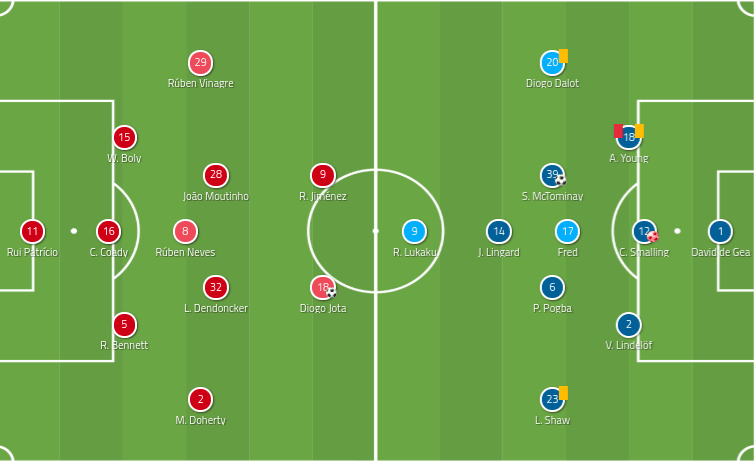
Ole Gunnar Solskjær paid Nuno the biggest compliment possible by matching the Black Country side in terms of formation, opting for the utilisation of wing-backs for the first time in his stint in charge of United. From the side that beat Watford on Saturday, Phil Jones, Nemanja Matić, Ander Herrera, Juan Mata, Marcus Rashford and Anthony Martial were withdrawn. In their place came Diogo Dalot, Fred, Victor Lindelöf, Scott McTominay, Jesse Lingard and Romelu Lukaku.
Following their dismal defeat at Burnley over the weekend, Nuno rang some changes of his own. Ryan Bennett, Rúben Vinagre, Matt Doherty and Raúl Jiménez came in for Adama Traoré, Romain Saïss, Jonny and Ivan Cavaleiro.
With Ashley Young starting on the right-hand side of a back three, it was perhaps somewhat inevitable that he was going to end up in trouble. Perhaps the most surprising part of Young’s dismissal was that he lasted as long as he did as he was terrorised all evening by Jota.
Knowing the system
While Solskjær’s side would have undoubtedly have been working on the 3-5-2/5-3-2 formation in training, there is an art to it. You have to admire the United head coach and his trying nature but Wolves have perfected the system since Nuno arrived at the club in the spring of 2017. The Portuguese adopted a 3-4-3 originally, but the defensive side of it is much the same, and because of this the players are right for the system and the system is right for the players.
For United, the system was just right for this match. Period. Or not, as the story goes. Young is not a right-sided centre half and Smalling is most definitely not a sweeper who can spray balls in the same way that Wolves’ Conor Coady can.
As illustrated by the image below, the contrast is stark between the two respective teams.
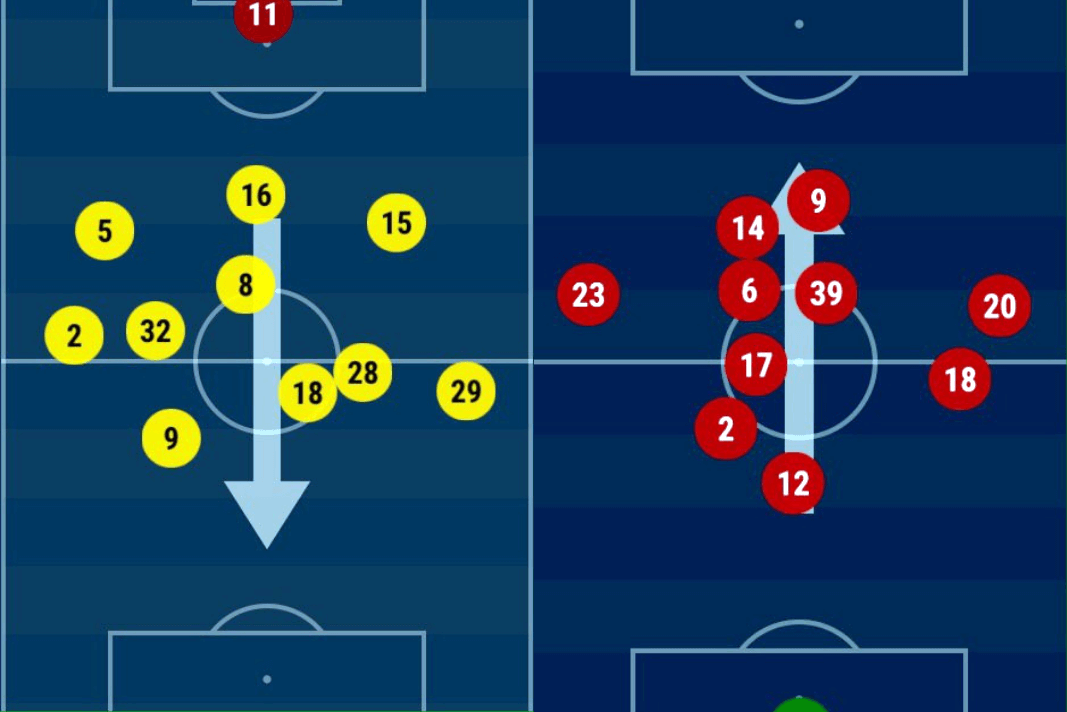
Ignoring the fact that David de Gea is cut out the picture, let’s look at the players in groups, beginning with the back three. Bennett (#5), Coady (#16) and Willy Boly (#15) are in a line with Coady slightly deeper as he acts as the sweeper of the trio. It wouldn’t be abnormal to see Boly play the ball into Coady and for the club captain to play it out the other side.
Now, look at United’s three: Smalling (#12), Lindelöf (#2) and Young (#18). Smalling is at the base which is right, but then look at how much further forward Young is in comparison to his Swedish teammate, Lindelöf.
The midfield three are too close together for United. Paul Pogba (#6), McTominay (#39) and Fred (#17) are all on top of each other, or thereabouts.
Wolves’ midfield run the show
Comparatively, Leander Dendoncker (#32), Rúben Neves (#8) and João Moutinho (#28) are evenly spread out across the pitch. Note how Dendoncker and Moutinho play closely with the wing-back on their side. You could drive a bus in the space between McTominay and Dalot (#20), just as with Pogba and Shaw (#23).
In United’s defence, one area they did get right was the aforementioned wing-backs. Dalot and Shaw both played high up the pitch and remained a threat throughout the game, even after Young was given his marching orders.
It wouldn’t be fair to look at the strikers as Lingard’s role changed after the sending off, so his average position is skewed.
United should’ve had the game put to bed
Lingard shocked seemingly everyone in the stadium as he burst straight from kick-off and fired an attempt at the Wolves goal. Nuno may well have been hoping that it would’ve woken his side up, but United continued to pile on the pressure. Even though it was McTominay that broke the deadlock, it could’ve been game over before Jota equalised.
From an xG perspective, Lingard (0.41) and Lukaku (0.56) really should’ve scored either side of McTominay’s opener (0.02) but were thwarted by the outstanding Rui Patrício who kept them at bay. McTominay had a golden opportunity (0.42) after the restart to double his United tally for the season. Nevertheless, the Portuguese number one was in the way.
For a better understanding, see the xG timing chart, which is below.
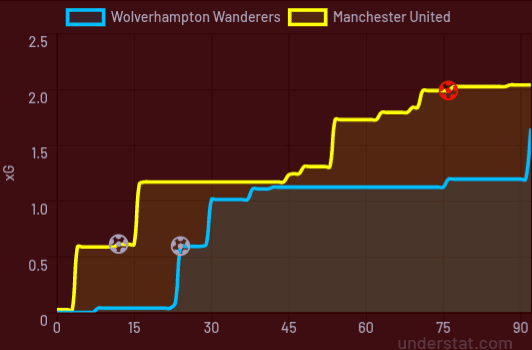
Once Jota (0.51) drew Wolves level, United didn’t register another attempt in the first half. It was a real half of two halves, some might say. Six minutes after Jota equalised, Dendoncker had a magnificent chance (0.4) to turn the game on its head, but he spooned his chance over the bar, albeit with his weaker foot.
Naturally, the own goal doesn’t register on the xG scale and Wolves didn’t really muster an attempt on goal until the dying embers of the game when Cavaleiro cannoned a shot off the crossbar (0.45) when it was arguably easier to score.
The art of keeping Pogba quiet
When something happens once, it could be attributed to a fluke or maybe luck. When something happens twice, arguments could be formed that it’s no more than coincidence. Three times is a pattern, no doubt. Tuesday night was the third time Wolves and United have faced each other this season and it was the third time that the French World Cup winner has been practically non-existent.
Back in September, Moutinho did a marvellous job of keeping him quiet. More recently, it’s been Dendoncker doing just that. The Belgian is a very intelligent player who’s more than happy to allow the opposition space, providing it’s not critical. Due to this fact, Dendoncker is able to cover a lot of ground and produce late bursts into the penalty area, should it be required.
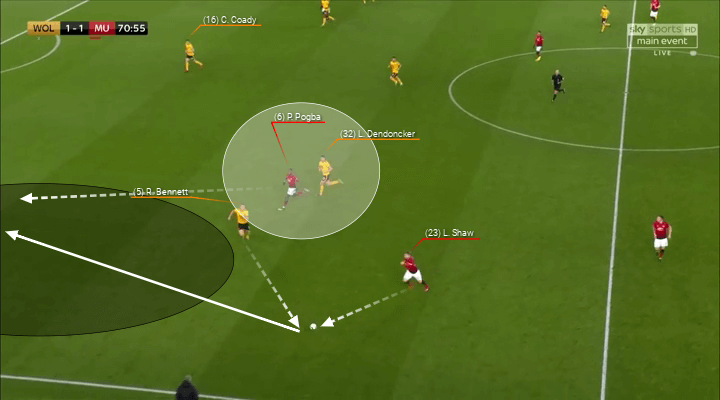
With Bennett charging out of position to battle Shaw for the ball, there’s an almighty hole on the right side of Wolves’ defence. Pogba realises this and is ready to go. As is evidenced from Coady’s somewhat relaxed stance, he’s not too concerned with what’s unfolding in front of him. If we look at the next still from the action, it’s clear why.
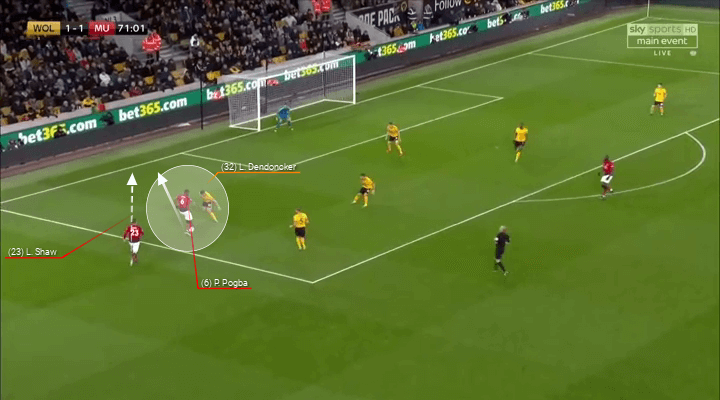
Despite Pogba’s attempts to dazzle Dendoncker with stepovers and what have you, the former Anderlecht man isn’t phased. Pogba goes to play the obvious ball to Shaw but is blocked off by Dendoncker and eventually forced backwards.
There are countless other examples of this throughout the match as Pogba’s passing percentage was only 70%, the third lowest of the 20 outfield players. In case you’re wondering, the two worse off than Pogba were also United players, namely Young and Dalot.
Final thoughts
Overall, Wolves were fortunate to not be behind, yet despite this Wolves were deserved winners as they restricted United to shots from outside the area, most of which were blocked.
Vinagre on the left was a brilliant outlet for Wolves and behind Dendoncker, arguably the best player on the pitch. At only 19 years old, the Molineux side have a wicked prospect on their hands.
Next on the menu, Wolves have a huge game against Watford at Wembley in a FA Cup semi-final. United face a certain Catalan side by the name of Barcelona…
Until the next time.
If you love tactical analysis, then you’ll love the digital magazines from totalfootballanalysis.com – a guaranteed 100+ pages of pure tactical analysis covering topics from the Premier League, Serie A, La Liga, Bundesliga and many, many more. Buy your copy of the March issue for just ₤4.99 here, or even better sign up for a ₤50 annual membership (12 monthly issues plus the annual review) right here.

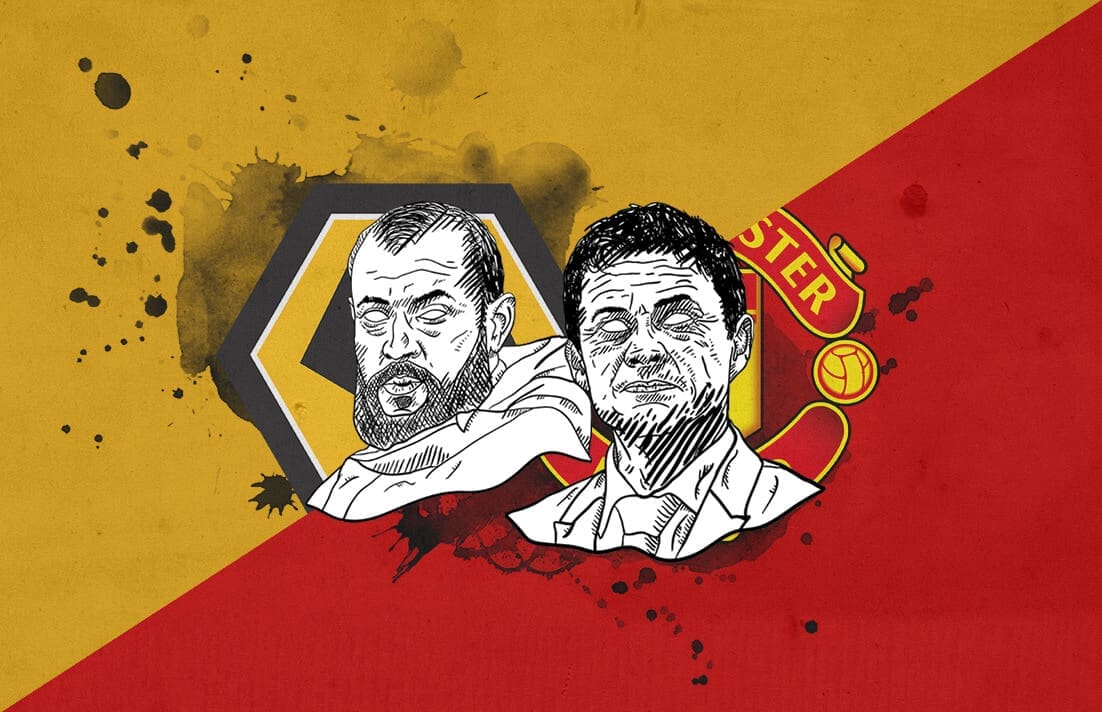



Comments